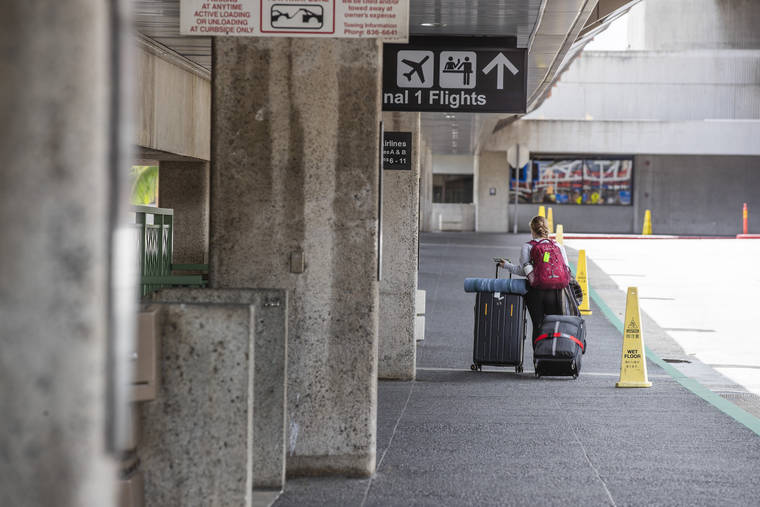Editorial: Make Hawaii’s quarantine rules more effective

CINDY ELLEN RUSSELL / CRUSSELL@STARADVERTISER.COM
A traveler headed to Terminal 1 at the Daniel K. Inouye International Airport on May 18.
Some of Hawaii’s recent daily visitor arrival counts are the highest since the 14-day quarantine order Opens in a new tab hitched to most air travel here began more than two months ago. So far this month, those tallies have topped 400 every day.
While many visitors — and returning residents — are complying with the state’s self-imposed quarantine rules, it’s worrisome that some have little or no intention of following suit. In addition to a string of on-island arrests in connection with violations, would-be scofflaws are being stopped upon airport arrival.
Over a span of about two months, the Visitor Aloha Society of Hawaii has assisted upwards of 80 travelers arriving without a place to complete quarantine — and, in most cases, no plan to honor the requirement. Many have been boarded on flights back home through the COVID-19 Flight Assistance Program, funded by the Hawaii Tourism Authority.
Starting Tuesday, the quarantine mandate will be lifted for interisland travelers who can clear a layered screening system that includes filling out a form specifying travel details, and undergoing temperature checks and a cross-check against a quarantine database.
While the state cannot require anyone to submit to COVID-19 testing, plans are in the works to offer swab tests to travelers meeting certain criteria. And in some cases, travelers will be directed to undergo quarantine as a safeguard against coronavirus spread.
In an effort to tighten up compliance, state leaders piecing together the screening system, dubbed “safe travel corridors,” should expand quarantine enforcement efforts and consider ramping up the current violation penalty — a misdemeanor, punishable by up to a $5,000 fine and one year in jail.
Don't miss out on what's happening!
Stay in touch with breaking news, as it happens, conveniently in your email inbox. It's FREE!
Hawaii is leading the nation in the public health response to the pandemic, holding a steady ranking among states with the lowest number of cases per capita. Also, we have low counts of cases requiring hospitalization; and less than 2% of swab tests are yielding positive results.
This enviable status is based in large part on economic sacrifice, in addition to residents and visitors assuming personal responsibility for adhering to social distancing and sanitation directives.
While Hawaii’s public health profile rightly boosts confidence that dialed-down restriction on interisland travel is manageable, lifting the quarantine on out-of-state travelers, especially from the U.S. mainland, is another matter entirely.
The nationwide count of confirmed COVID-19 cases this week surpassed the 2 million mark, with infection rising at alarming rates in hotspots as restrictions on public life have been relaxed in varying degrees. Noting spikes in markets key to Hawaii’s tourism industry, including several western states, Gov. David Ige has extended the trans-Pacific quarantine through July.
The painful upshot is that while the kamaaina- focused economy is slowly reopening, much of the tourism-fueled sector will remain at a near-halt through summer months — and likely miss the lucrative season entirely. At this time last year, the state’s economic engine was humming, with nearly 30,000 airline passengers arriving in Hawaii daily.
It is a delicate balance: A too-early lifting of the out-of-state quarantine could bring us a surge in COVID-19 cases.
Hawaii’s reopening steps are dependent on the count of cases, health-care system capacity, and ability to keep pace with demand for prioritized testing and contact tracing. Health officials and others are ready for the uptick in risk that will accompany the interisland quarantine lift.
But as a buffer against reversing progress toward fully reopening to “new normal,” a thorough test-driving of the state’s travel corridors system is necessary on this rough road toward welcoming back out-of-state travelers with lighter restrictions.



